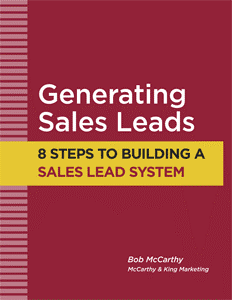You’ve got to love drip email. I know I do.
 Anytime you can use automation to perform a critical step in your sales process – well, that’s a good thing.
Anytime you can use automation to perform a critical step in your sales process – well, that’s a good thing.
It’s especially helpful when you think about how many leads routinely fall through the cracks because you (or your sales people) don’t have the time to stay in touch with every lead.
I started using drip email a few years ago and I am still amazed when I see prospects responding to one of my emails that I created such a long time ago.
It reminds me that people who joined my list or downloaded one of my ebooks are still hearing from me on a consistent basis even when I’m too busy to write something new.
But most of us never come close to using drip email to its full capacity. Today, most email service providers and marketing automation systems allow you to create multiple email streams for different prospects in different industries at different stages in the sales process.
But it takes time to write, design and set up these emails. The good news is that once you are done, there’s nothing left to do other than check the emails on occasion to make sure they are still correct and relevant.
There are many ways to use drip email campaigns. I’ve come up 15. You may have others – and if so, I’d like to hear from you.
- Welcome to our community. This is by far the most common use of drip email campaigns. A new visitor to your website joins your email list, and as a follow up, you send them a series of emails welcoming them and introducing them to your company.
- Product or service-based messaging. A software company offers multiple software products. When new prospects join the company email list, they are asked about their product interest. Separate email sequences are developed for each product and then delivered to those with a specific interest in those products.
- Industry based messaging. Many firms sell the same product to multiple industries and often send the same message to all industries. An industrial manufacturer sells its testing product to various industries – medical, pharmaceutical, automotive and packaging. By creating separate email streams for each industry, they can talk to their industry prospects with language and examples that are relevant to them.
- Job function-based messaging. In B2B selling, multiple people can influence the buying the decision, but their interest in the product or service will vary. A CEO may look at the product from a strategic or broad view standpoint. A line manager or employee may look at the same product from a tactical perspective. A drip email campaigns allows you to reach each person or job title with a different message.
- Company size-based messaging. Sometimes, a company will offer multiple options for the same product or service. For example, customers might have the choice of purchasing the basic product, a premium version or a low-cost “lite” version. While all prospects may be eligible to purchase any level, you may want to focus on one of the options depending on what each audience is most likely to buy.
- Application-based messaging. Sometimes the same product performs different tasks for different people. An Excel spreadsheet may be used to manage the books for accounting, but may also be used to manage a database for marketing. If you know who is going to use your product, you may want to create separate drip emails around each application.
- Educational or tutorial series. One very effective way to generate leads and position yourself as an expert in your field is to create a series of tutorials. These can be in written or video form. If you prepare all the tutorials in advance, you can then package them as a tutorial email series – and send them out as a daily or weekly lesson.
- Product feature emails. When you have a lot to say about your product, you can say it all in one email – or you can break it down into a series of emails. Sometimes delivering your message in small chunks is better than one large helping. Along the same lines, you could create a building block sales message so that each successive email adds one more block to the full message.
- Sales stage emails. Every prospect moves through your sales funnel from one step to the next. They start at the top of the funnel with an inquiry, but eventually move into a more a serious stage by attending a webinar, replying to a survey or requesting a demonstration. As prospects move down the funnel, you may want to switch them over to a different email series – one that is more relevant to their stage in the sales process.
- Trial countdown emails. If you are using a free trial or a low-cost trial to acquire new customers, you can use drip email to send reminders that the trial is coming to an end. Similarly, you can create separate email streams for new trial signups who don’t actually begin the trial.
- New customer welcome emails Many companies have a process for “on-boarding” a new customer. This is usually outlined with a step-by-step instruction sheeet. Why not break up that process with multiple emails delivered over the course of several days.
- Upsell/cross-sell emails. They say you should starting working on your second order as soon as you close your first. Timing is up to you, but it is true you need to think about your upselling or cross-selling strategy right away. It would makes sense, therefore, to create a series of emails that go out to all new customers on a pre-arranged schedule.
- Event follow-up emails. Events can be many things to a marketer – exhibiting at a trade show, speaking at a conference or running your own seminar or webinar. With all of your events, you can use drip email as a follow-up series to attendees. You can also create a separate series for those who sign up but who do not attend.
- Reactivation emails. No matter how hard you work, there will always be some customers and prospects who are no longer engaged with you. This happens for many different reasons – they’ve lost interest, hired a different company, no longer need your product or service or they’re just too busy. A drip email campaign could be designed to reactivate those lapsed customers and prospects.
- Collection emails. Not really a marketing function, but a series of emails may be all you need to collect on some of your overdue invoices. It’s worth a shot before you start to make phone calls or go to a collection agency.
This is by no means a complete list. Please send along your ideas for additional uses of drip email. I will add them to the list.
Would you like help setting up a drip email series?
Give us a call. We can help you in two ways:
- Drip email setup and execution
- Drip email writing and design
————————
Written by Bob McCarthy
Bob McCarthy is a direct response consultant and writer specializing in direct marketing, digital marketing and lead generation.
If you liked this article, please join our email list and get more articles just like it.
Download our FREE ebook,
Generating Sales Leads
8 Steps to Building a Sales Lead System
- A High-Wire Act for Today’s Marketers - January 28, 2021
- Is it content – or just copy? - May 26, 2020
- How you can – and why you should – use your website to teach - May 12, 2020
- How to Generate Qualified Leads with Lead Surveys - March 1, 2020
- Gaps in your Email Schedule – and how to avoid them - September 4, 2019
- The Dizzying World of Letter Mail - July 22, 2019
- Do you have an Information Kit? - June 25, 2019
- Direct Mail and Those Pesky Millennials - November 8, 2017
- Landing Pages: Do you need a squeeze page or sales page – or both? - May 31, 2017
- Do you have the patience for content and inbound marketing? - May 6, 2017


